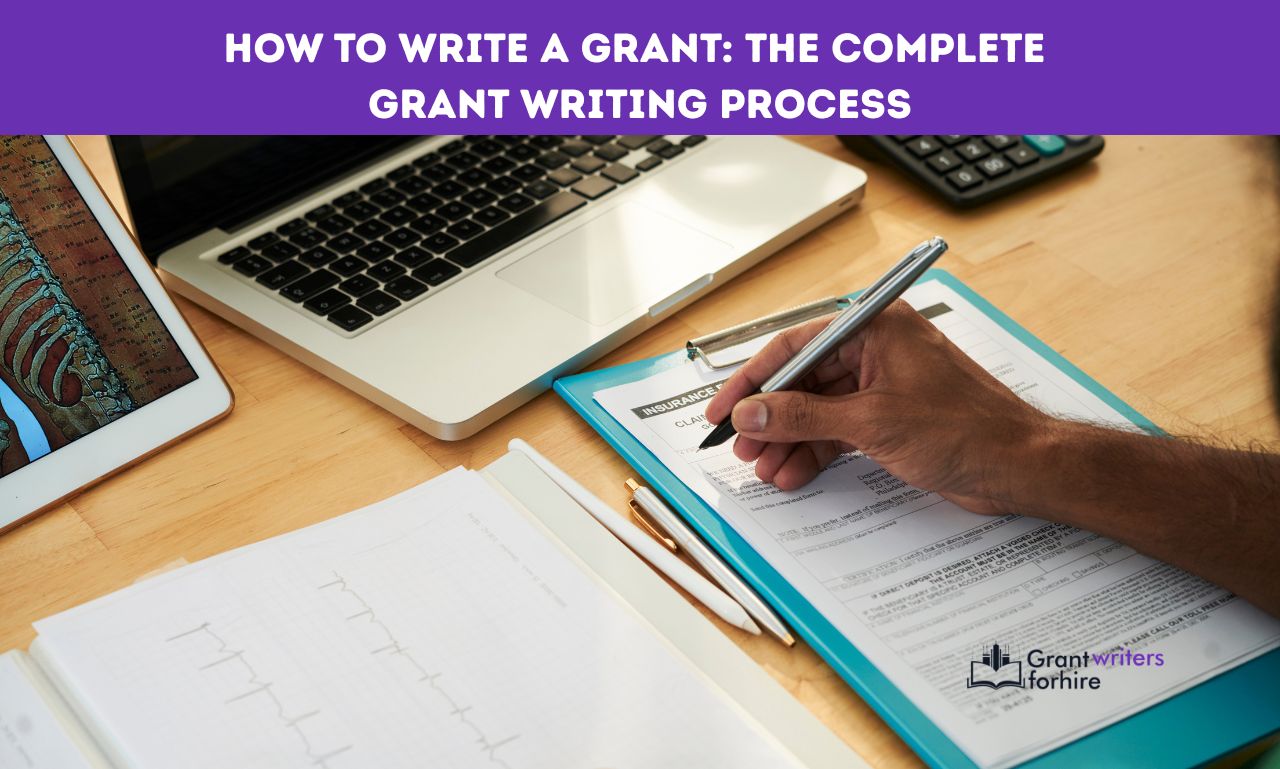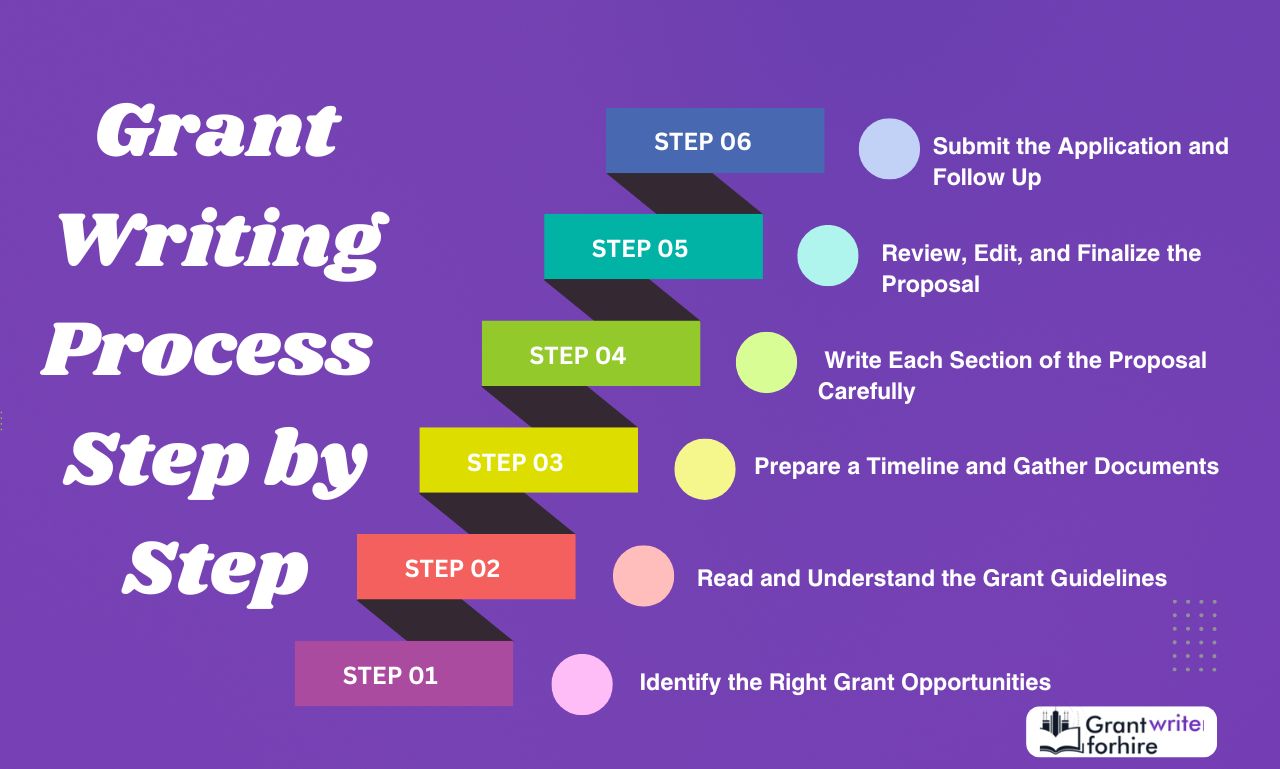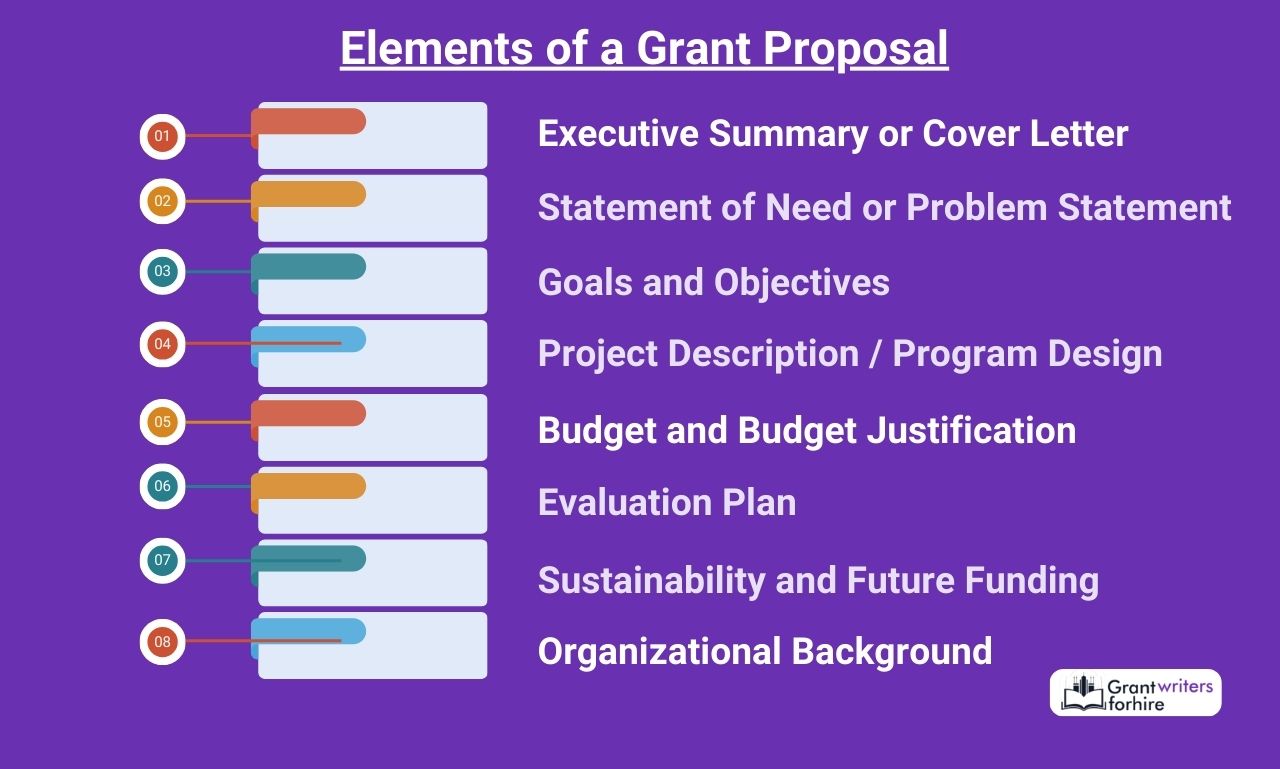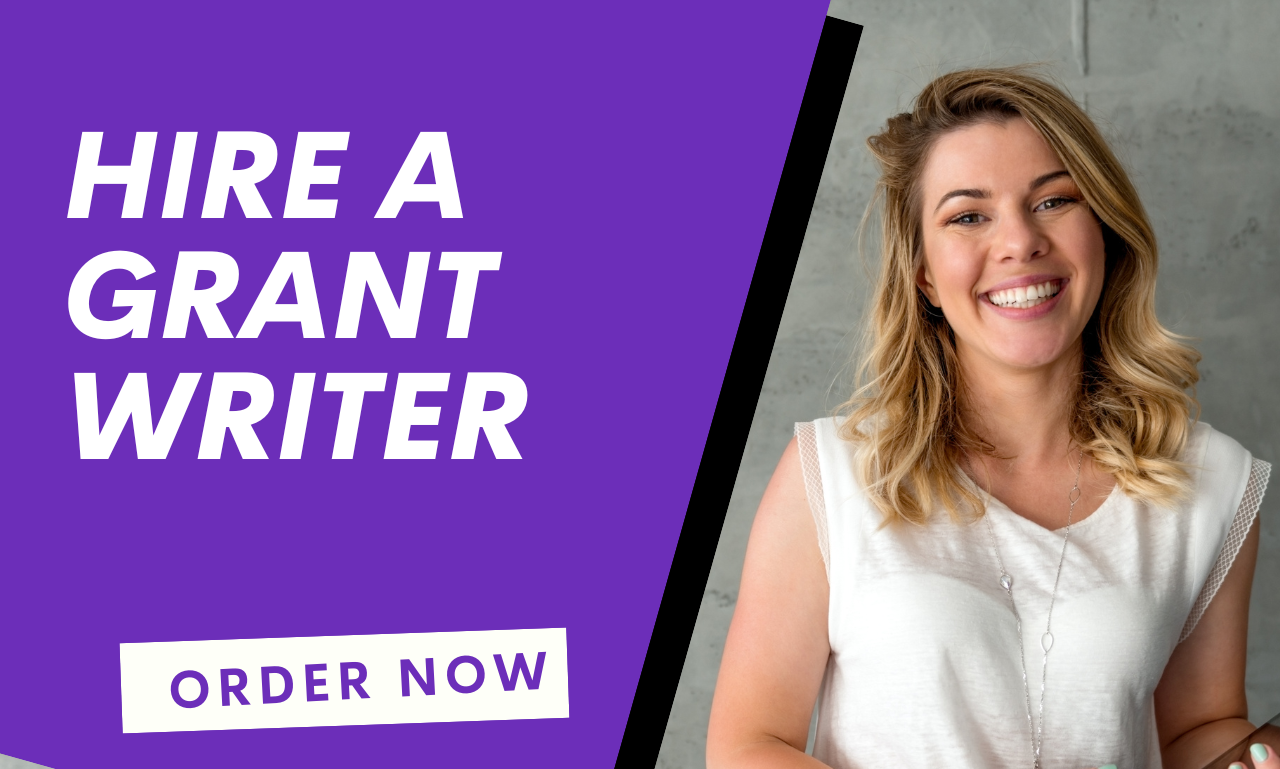How to Write a Grant: The Complete Grant Writing Process
A grant proposal is a written request for money to help with a project or goal. It explains what you plan to do, why it is important, and how the money will be used. The goal is to show that your idea is helpful and worth supporting.

Many people and groups need grant writing, like nonprofits that help communities, schools that need tools or programs, researchers who want to study something new, and businesses that want to grow. Even artists and students can ask for grants to support their work or education.
There are different types of grants available. Government grants that come from city, state, or national offices. Foundation grants from private groups that support good causes. There are also corporate grants given by companies that want to help people or support local projects. Each grant type has its own rules, but they all want to support strong ideas that bring positive change.
Grant Writing Process Step by Step
The grant writing process is a well defined way to request funding for a project or program. It involves following clear steps to ensure the proposal is well organized and easy to understand. Each step helps present the idea in a strong and organized manner. By following this process, individuals and organizations improve their chances of receiving support. It is an important approach for those seeking funding to create positive change.
Let us look at these steps;

Step 1 – Identify the Right Grant Opportunities
The first step is to look for grants that match your project or goal. Not every grant is a good fit, so you must read the details carefully. Check who the grant is for and what kind of work it supports. Some grants are for schools, some for health programs, and others for small businesses. Choosing the right grant saves time and increases your chances of getting funded. It is better to apply for fewer grants that match well than many that do not.
Step 2 – Read and Understand the Grant Guidelines
Once you find a good grant, the next step is to read the guidelines. These are the rules you must follow when writing and sending your proposal. The guidelines explain what to include, when to send it, and how to format your work. If you miss a rule, your proposal might be rejected. Take notes and highlight key parts so you do not forget them. Reading carefully helps you follow instructions and stay on track.
Step 3 – Prepare a Timeline and Gather Documents
Before writing, make a timeline and collect all the documents you need. This includes things like your project plan, budget, and background information. A timeline helps you manage your time and meet the deadline. Getting documents ready early saves you from rushing at the last minute. Staying organized makes the whole process smoother. It also shows that you are serious and ready to do the work.
Step 4 – Write Each Section of the Proposal Carefully
Now it is time to start writing the proposal, step by step. Each part should be clear and explain your project well. Make sure to include your goals, who you will help, and how the money will be used. Use simple words so it is easy to understand. Follow the outline given in the grant rules. Take your time so that each section is done properly.
Step 5 – Review, Edit, and Finalize the Proposal
After writing, it is important to check your work. Read everything again to fix spelling or grammar mistakes. Make sure all parts are included and nothing is missing. Ask someone else to read it too, they might see things you missed. A clean and complete proposal makes a better impression. Final checks help you submit your best work.
Step 6 – Submit the Application and Follow Up
The last step is to send your proposal before the deadline. Make sure you follow the submission instructions exactly. Keep a copy of what you send, just in case. After you submit, you can send a polite message to confirm they got it. Waiting for an answer can take time, but following up shows that you care. This final step closes the process and keeps the door open for future grants.
Elements of a Grant Proposal
A grant proposal is made up of different parts that work together to explain your idea. Each part has a role, like showing the problem, your solution, and how the money will be used. These elements help the funder understand why your project is important and worth supporting. When all parts are clear and well written, your proposal has a better chance of getting approved. Knowing these elements is the first step to writing a strong proposal.
The following is an image of the elements of a grant proposal;

Executive Summary or Cover Letter
The executive summary or cover letter is the first part of the grant proposal. It gives a short overview of your project and asks for funding. You should include your group’s name, what the project is, how much money you need, and why the project is important.
This part helps the funder quickly understand what you are asking for. Even though it is short, it must be clear and strong. It is like a quick introduction that gives the big picture. If this part is done well, the reader will want to keep reading. It sets the tone for the rest of the proposal.
Statement of Need or Problem Statement
The statement of need explains the problem your project will solve. It shows why the project is important and who it will help. You can include facts, numbers, or stories to make the problem clear. This part helps the funder understand why action is needed now.
It should also show that the problem is real and affects many people. A strong problem statement makes the proposal more convincing. It helps the reader care about the issue. When written clearly, it builds support for your idea.
Goals and Objectives
Goals and objectives explain what you want to achieve with your project. A goal is a big result you hope to reach, while objectives are smaller steps that help you get there. For example, your goal might be to help students read better, and your objective could be to give reading lessons twice a week.
This section shows that you have a clear plan and know what success looks like. Each objective should be specific and easy to measure. Funders want to know what they are paying for. If your goals are strong and realistic, it helps build trust. It also shows that you can finish what you start.
Project Description / Program Design
The project description explains what you will do, how you will do it, and who will be involved. It includes the steps, timeline, and tools you will use. You should also explain where the project will happen and who it will help. This section is the heart of your proposal because it shows the plan in action.
It should be easy to follow and well organized. Funders want to see that your plan makes sense and can really work. A strong project design gives confidence that the money will be used well. It helps the reader see your idea as real and ready.
Budget and Budget Justification
The budget shows how much money you need and what it will be used for. It should list items like staff pay, equipment, supplies, or travel. The budget justification explains why each cost is needed. This part helps funders see that you are using money wisely. You should be honest and clear with all amounts.
A good budget shows that you have planned everything well. Funders want to know where their money is going. If your budget is clear and fair, they will feel better about giving support.
Evaluation Plan
The evaluation plan explains how you will check if your project is working. You need to show how you will measure success. This might include surveys, reports, or other tools. Funders want to see that you will not just start the project, but also track its progress.
This shows that you care about results, not just starting the work. You should explain who will do the checking and when. A strong evaluation plan shows you are serious about doing a good job as well as prove that the project is making a difference.
Sustainability and Future Funding
This section shows how you will keep the project going after the grant money ends. Funders like to support projects that last a long time. You can talk about other funding sources, community support, or income from services. You should explain your long-term plan clearly.
Funders want to see that you are not only depending on one grant. Showing a plan for the future gives them more trust in your work. It also shows that you are thinking ahead. This part proves your project is strong and can grow over time.
Organizational Background
The organizational background tells the funder about your group. It includes your mission, history, past work, and who you serve. You can also talk about your team and why they are ready to do this project. Funders want to know that your group is experienced and trusted.
If you have done similar projects before, this is the place to say it. You can also mention awards or partnerships that show your success. This section helps funders feel confident in your group. A strong background builds trust and support.
How to Make Your Grant Proposal Stand Out
To make your grant proposal stand out, it is important to write clearly and with purpose. Every sentence should explain your idea in a simple way so the funder can understand it easily.
You should also make sure your mission matches what the funder cares about. This helps them see that your goals and their goals are the same. Use facts, data, and research to show that the problem is real and your project is a good solution.
Add numbers or past results to prove that your idea can work. Include clear outcomes and how you will measure them, so the funder knows what success looks like.
Talk about how your project will include different people and help the whole community. Show how you plan to treat everyone fairly and give support to those who need it most. When your proposal is clear, honest, and focused on real change, it has a better chance of getting funded.
Common Mistakes to Avoid When Writing a Grant
When writing a grant, there are common mistakes that can lower your chances of getting approved. One big mistake is ignoring the rules or going over the word limit.
Funders often set clear instructions, and not following them shows that you are not careful. Another problem is sending an incomplete application. If parts are missing, the funder may not even read it.
Using hard words or unclear language is also a mistake because it makes your idea hard to understand. Always use simple, clear sentences. Some people forget to show how their project will make a difference or how it will keep going after the money is used.
Funders want to know your plan is strong and will last. Avoiding these mistakes can help your proposal stand out in a good way.
Do You Need a Grant Writer? When to Get Help
Many people wonder if they need help writing a grant. If you are new to grant writing or have a big project, getting help can make things easier.
A professional grant writer knows how to follow the rules, explain ideas clearly, and increase your chances of getting money. They save you time and help you avoid common mistakes.
When choosing a grant writing service, always check their past work and reviews. Ask if they have experience with the type of grant you need. Make sure they understand your goals and can explain their process.
Do not choose someone just because they are cheap, look for someone with good results. Getting the right help can make your proposal stronger and more likely to win funding.
Grant Proposal Checklist
A grant proposal checklist helps you make sure everything is complete before you send your application. First, always proofread your work to fix spelling and grammar mistakes.
Check that all parts of the proposal follow the funder’s rules. This includes word limits, file type, and what sections to include.
It is important to make sure your budget matches the grant business plan you wrote. If you say you will run a training, the budget should show money for it. Also, check that your file has the right name and format, like PDF or Word.
Follow the funder’s rules for how and when to send it. These small details matter and show that you are serious and well prepared. A good checklist helps you avoid mistakes and submit your best work.
Grant Writing Process FAQs
How long does it take to write a grant proposal?
Writing a grant proposal usually takes a few weeks. You need time to plan, collect documents, and write each part. It also takes time to review and fix mistakes before sending it. The bigger the project, the longer it may take.
What’s the success rate for grant applications?
The success rate is often low because many people apply for the same funding. This means your proposal must be clear, complete, and well aligned to the funder’s goals. Following all the rules gives you a better chance.
Can I reuse one grant proposal for multiple funders?
Yes, you can reuse some parts like your mission or background. But you must change parts of the proposal to fit each funder’s rules and focus. Sending the same version to everyone is not a good idea.
Do funders provide feedback if a grant is denied?
Some funders give feedback, but others do not. If you get feedback, it can help you learn and improve for the next time. It is okay to ask politely, even if they reject your request. Learning from each try makes your next proposal stronger.

